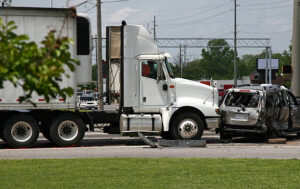While driving, the space between your vehicle and the one in front of you is your only protection from a rear-end collision. Every professional driver understands this truth. Most are taught early in their careers that a fully loaded tractor trailer that’s going 60 mph needs more than the length of a football field to stop — and that’s when conditions are good.
Yet, on any highway with moderate to heavy traffic, it won’t take long to spot someone driving an 18-wheeler and following the vehicle ahead too closely.
The results can be deadly. A four-wheeler is no match for a large truck, and for a rig to tailgate the smaller vehicle is tantamount to a death sentence for the occupants if anything goes wrong. It’s a deadly practice, but some drivers either don’t understand or don’t care, or a combination of both.
Not only is the practice a foolish one, but it can also cost a driver’s job or a career, even if there isn’t an accident. Following too closely is listed as a “serious violation” by the Federal Motor Carrier Safety Administration (FMCSA). Two serious violations within a three-year period are an automatic 60-day disqualification for the driver. Other violations listed as “serious” are excessive speeding (15 mph or more over the limit), reckless driving, and improper or erratic lane changes.
The FMCSA doesn’t disqualify for a first offense, but many carriers consider serious offenses to be grounds for termination. You may not be fired until you’ve had your day in court — but you can be suspended without pay until your court date. Finding another driving job will be very difficult with a conviction for a serious violation on your record.
Actually, you don’t even need to be convicted. A warning for a serious violation — or even a ticket for which you were found “not guilty” in court — can still appear on the Pre-Employment Screening Program (PSP) report ordered by the carrier you apply to. There’s a process for having a non-conviction removed, but it takes months … and your request may be denied.
Part of the reason for this strictness is insurance, which is a big expense for carriers. That expense gets bigger when there are drivers with records of serious violations on the payroll. If litigation happens due to an accident, the plaintiff’s attorney will demand safety records from the carrier. If a carrier hires or retains drivers with serious violations on their records, lawyers can use that information to make a case that the carrier itself isn’t safe.
Space is the key to helping a driver maintain a safe driving record.
The space in front of your vehicle is most important — but it’s not the only space you should be aware of. It’s good practice not to allow other vehicles to travel alongside you for any length of time. A gust of wind, an object in the roadway or even a sneeze can make your rig swerve to the left or right, putting vehicles alongside yours in danger. Some defensive driving courses teach drivers to have an “escape route” they can take if traffic ahead stops suddenly. Your best escape route is the space ahead.
Speed is another important piece in the safe-driving equation, and speeding is worse today than ever. Because of electronic logs, just-in-time shipping practices and a shortage of available parking in some areas, drivers attempt to make the most of their available driving time each day. Some drivers choose to exceed the speed limit in an effort to cover as many miles as possible before time runs out. Speeding is a practice that runs counter to safety principles, but many drivers feel that it’s a necessary part of earning a paycheck on the road.
Aside from the risk of earning a serious-level violation because of excessive speeding, the faster you go, the more your stopping distance increases. Plus, traveling faster often has other results, such as the need to change lanes frequently to avoid slower traffic. When drivers can’t avoid traffic, they often wind up following other vehicles too closely.
Keep in mind that it’s possible to “speed” even when driving at or below the speed limit. When road conditions are bad or visibility is impaired, you can be moving well under the speed limit but still driving too fast for conditions. If roads are wet or icy, the results can be catastrophic.
Parking lots and shipper or receiver yards are also areas where speeding occurs. Drivers must be prepared and able to stop if a truck pulls out from a dock or a pedestrian walks in front of the vehicle.
Speed is also related to the space around your vehicle — in fact, speed is usually how you adjust that space. If there isn’t enough space in ahead, slow down. Sure, someone might occupy that space, including cars that were behind you and passed. The reality is that they had to be traveling faster to pass your truck; if they don’t change speed, they will quickly pull away, giving you more following distance. If they don’t, however, it becomes your responsibility to reduce your speed until there is sufficient space in front again.
Some truckers solve the problem by driving one or two mph slower than surrounding traffic, allowing faster vehicles to pass them. Other drivers, however, try to go a little faster, hoping to eventually get around the heavy traffic. The stress of driving a tractor-trailer is high enough. Trying to get ahead through a ton of traffic is a sure way to drive stress levels higher. Conversely, slowing down and letting the traffic do its thing is far more relaxing.
Finally, remember this: No driver has ever emerged from an accident scene wishing they had been driving faster or following more closely.
Cliff Abbott is an experienced commercial vehicle driver and owner-operator who still holds a CDL in his home state of Alabama. In nearly 40 years in trucking, he’s been an instructor and trainer and has managed safety and recruiting operations for several carriers. Having never lost his love of the road, Cliff has written a book and hundreds of songs and has been writing for The Trucker for more than a decade.









